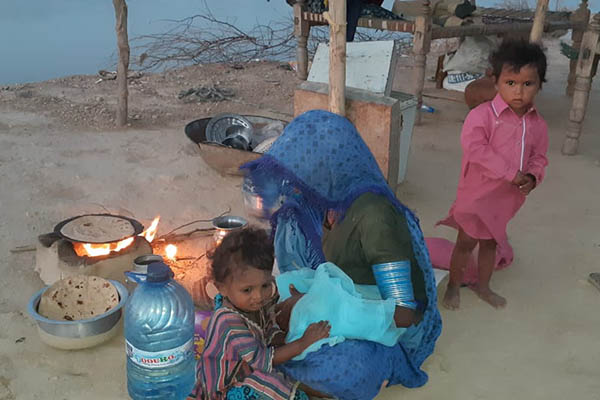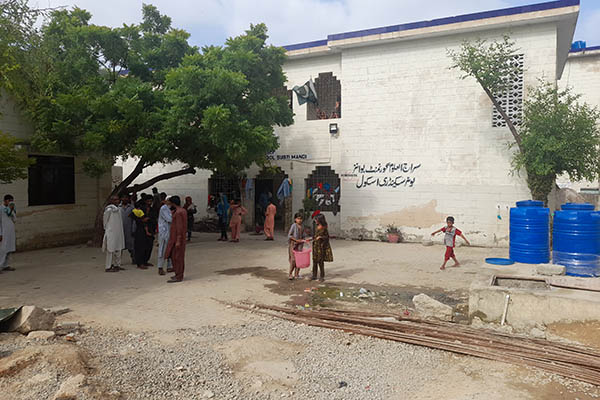
A woman takes care of her newborn child in Johi, Dadu. Photo by Mashooque Birhmani
The floods that ravaged a third of Pakistan this year—affecting over 33 million people and destroying more than 4 million acres of farmland—have not only left a looming food insecurity crisis, but also damaged healthcare infrastructure, endangering the lives of infants and pregnant women, many of whom now have to travel lengthy distances just to see a doctor or receive medicine.
Even prior to the floods, the Food and Agriculture Organization of the United Nations had warned of the threat posed by food insecurity in 17 of 59 districts that were inundated by floodwaters. In a report issued earlier this month, it said around 3.5 million people in the impacted districts were estimated to be acutely food insecure and in need of urgent assistance. Of these, it said around 2.5 million people were in Sindh and the rest in Balochistan. With the government already having to import essential food items to cover the losses caused by the floods, it is highly likely that food insecurity would increase substantially as authorities wait for waters to recede.
The dearth of proper nutrition, coupled with the complete collapse of already-dilapidated healthcare facilities, poses a particular threat for pregnant women, estimated to number over 650,000 nationwide, including nearly 130,000 who require urgent care. More than 42,000 women are due to give birth within the next three months, according to a preliminary assessment prepared by the United Nations Population Fund. A key requirement to prevent disaster, say healthcare providers, is accurate and updated data from official sources.
The Health Department of Sindh province, which has suffered the brunt of the climate change-induced disaster, estimates the presence of 9,573 pregnant women in relief camps, including 2,881 who are due to give birth soon; 3,985 in their second trimester; and 1,740 in their first trimester. Already, it says, 3,612 babies have been delivered in relief camps. All this amidst one of the worst climate change-induced disasters in a country that UNICEF considers among the worst for infant-maternal mortality.
Seeking relief
The surging floodwaters and destruction of livelihoods has forced hundreds of thousands in Sindh to move toward provincial capital Karachi, with many having walked hundreds of kilometers in the hopes of finding some reprieve. However, pregnant residents of relief camps set up by the government in public schools lament their miseries have only doubled amidst a shortage of healthcare facilities and urgent medical aid.
At the Sirjaul Uloom Government Boys Lower Secondary School on Karachi’s University Road, residents of a hastily organized relief camp crowd narrow corridors, with children roaming aimlessly as their families sit idly in semi-dark classrooms. “I have been married for 16 years. I have three children already—two young sons and an infant daughter—and am currently in my 10th month of pregnancy,” said Islam Bibi, 36, one of its pregnant residents who fled 379km to Karachi with her laborer husband after their native Khairpur Nathan Shah was inundated.
“I am in a lot of pain—I can’t sit or stand easily, nor can I walk,” she lamented, explaining that she had visited the Dow University Hospital after reaching Karachi a month back and was told to wait for her delivery. “A doctor in Khairpur Nathan Shah told me you will have the baby through operation … [but] the doctor in Karachi said as my previous deliveries were normal, this one would be too and I should wait,” she said, bemoaning the constant pain she’s in.
“My husband is a jaundice patient and I have to live with him here in a small space with my children. This is a great risk for me and my unborn born child but I don’t have any other option,” said the tearful Bibi.
Dr. Shershah Syed, a Karachi based obstetrician-gynecologist who has previously served as the secretary general of the Pakistan Medical Association, warned there was urgent need to ensure proper nutrition for pregnant women fleeing floods, especially with iron supplements, to offset anemia, which 70-80 percent of pregnant women in relief camps are afflicted with according to midwives. This, he stressed, was essential to prevent a surge in the maternal mortality rate.
Lamenting the situation could be even worse than available information would suggest, he noted there was no system in place to collect data on maternal mortality rates from far-flung relief camps. According to a report from the United Nations Children’s Fund (UNICEF), the rate of maternal mortality in Pakistan is “unacceptably high” at 170 per 100,000 live births. Similarly, it says, neonatal mortality has been stagnant for decades at about 55 per 1000 live births.

Residents of a flood relief camp in Karachi. Photo by Asifa Idrees
Difficult conditions
In one of the Karachi medical camps established by the government for flood victims, one of the doctors on duty told Pakistan Standard that pregnant women were referred to the Dow University Hospital if they needed any specific treatment. One of the women waiting to be examined, 21-year-old Samina, said she had traveled to Karachi from Mehar Tehsil of Dadu district.
“I have been married for a year-and-a-half,” she said. “I am eight-months pregnant with my first child and the journey to Karachi was especially difficult and painful because I had to sit in a narrow bus seat,” she lamented, saying she had felt she could die before she ever reached the Sindh capital. “I never imagined having to live in a relief camp in this condition,” she said, adding that a major concern was having to use the latrine. “The washroom is on the ground floor and we are staying on the first floor; traveling downstairs frequently is very difficult,” she said. But the substandard conditions at camps in Karachi are still significantly better than those found in camps set up closer to flood-hit regions.
Non-governmental organization Sujag Sansar is one of the groups working to provide healthcare to flood migrants who have been unable to travel to urban centers. Mashooque Birhmani, the organization’s CEO, told Pakistan Standard they were working in the Johi area of Dadu district to ferry pregnant women via boats to nearby hospitals. Unfortunately, he said, around six pregnant women had already died due to a lack of healthcare. Similarly, he regretted, around four newborns had died in the Kaccho area because boats were not available to shift them to hospital for timely treatment when they fell ill in the night.
“Hundreds of thousands of flood migrants are now in relief camps,” said Dr. Shershah. “Our team of 30 midwives, working in flood relief camps, is currently booking pregnant women. But making a booking is one thing; persuading them to deliver at a specified time and, if required, shifting them to nearby hospitals is another,” he said. “We have arranged a cesarean facility at the Kohi Goth hospital but many people are unwilling to go to hospital. They says if death comes they will die. It has happened before,” he lamented.
Seeking solutions
Talking about some solutions, he suggested treating pregnant women for intestinal or parasitic worms, especially as many flood victims had been forced to drink unsanitary water from stagnant pools. These same pools have also rung alarm bells because they are an ideal breeding ground for mosquitoes, which are key spreaders of diseases such as malaria and dengue.
According to the Directorate General Health Services Sindh, doctors treated 1,303 dengue patients in medical camps from July 1 till Sept. 27. However, as earlier noted by Dr. Shershah, there are no details of how many of these patients might have been pregnant women.
Sindh Health Minister Dr. Azra Pechuho frankly admits that collecting data has become “very difficult” because the floods have damaged or forced the closure of over 1,200 health centers across the province. “There are 9,000 pregnant women registered as flood victims in relief camps, but data related to patients suffering from dengue could not be received from private hospitals,” she admitted at a recent event in Karachi, raising questions over the accuracy of the available statistics.
Pakistan’s catastrophic floods have highlighted to the world the threats posed by climate change, especially on women in vulnerable communities. As the country moves from the rescue phase of flood relief to rehabilitation, it is vital that strategies be chalked out in advance to minimize the risks to women in general and pregnant women in particular to prevent unnecessary deaths.
